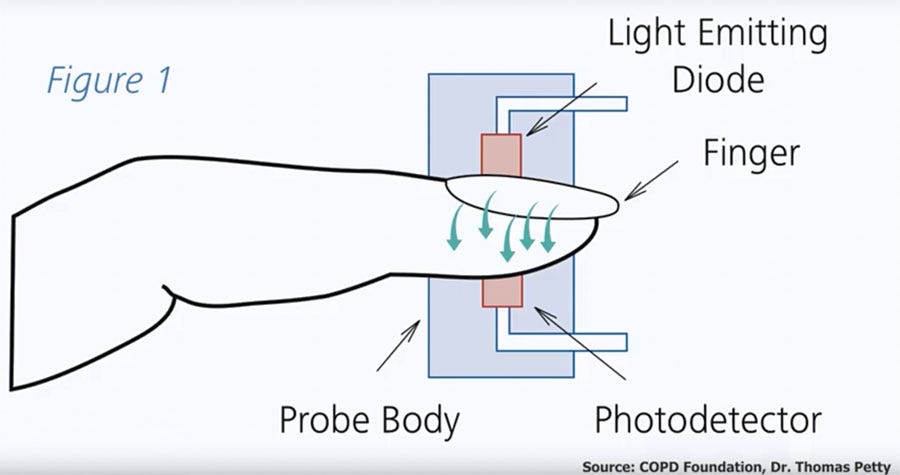Pulse Oximeters
A pulse oximeter is a medical device that indirectly monitors the oxygen saturation of a patient's blood. (As opposed to measuring oxygen saturation directly through a blood sample.)

Pulse oximetry uses a light emitter with red and infrared LEDs that shines through a reasonably translucent site with good blood flow. Typical adult/pediatric sites are the finger, toe, pinna (top) or lobe of the ear. Infant sites are the foot or palm and the big toe or thumb. Opposite the emitter is a photodetector that receives the light that passes through the measuring site.
There are two methods of sending light through the measuring site: transmission and reflectance. In the transmission method, as shown in the figure on the previous page, the emitter and photodetector are opposite of each other with the measuring site in-between. The light can then pass through the site. In the reflectance method, the emitter and photodetector are next to each other on top of the measuring site. The light bounces from the emitter to the detector across the site. The transmission method is the most common type used, and for this discussion, the transmission method will be implied.

After the transmitted red (R) and infrared (IR) signals pass through the measuring site and are received at the photodetector, the R/IR ratio is calculated. The R/IR is compared to a "look-up" table (made up of empirical formulas) that convert the ratio to a SpO2 value. Most manufacturers have their look-up tables based on calibration curves derived from healthy subjects at various SpO2 levels. Typically an R/IR ratio of 0.5 equates to approximately 100 percent SpO2, a ratio of 1.0 to approximately 82 percent SpO2, while a ratio of 2.0 equates to 0 percent SpO2.
At the measuring site, there are constant light absorbers that are always present. They are skin, tissue, venous blood, and arterial blood. However, with each heartbeat the heart contracts and there is a surge of arterial blood, which momentarily increases arterial blood volume across the measuring site. This results in more light absorption during the surge. If light signals received at the photodetector are looked at 'as a waveform,' there should be peaks with each heartbeat and troughs between heartbeats. If the light absorption at the trough (which should include all the constant absorbers) is subtracted from the light absorption at the peak then, in theory, the resultants are the absorption characteristics due to added volume of blood only; which is arterial. Since peaks occur with each heartbeat or pulse, the term "pulse oximetry" was coined. This solved many problems inherent to oximetry measurements in the past and is the method used today in conventional pulse oximetry.

Overview of Pulse Oximeters:
Pulse oximeters come in a variety of styles and accuracy levels. The entry level is considered a "sport" model, is battery operated and will provide a patient a reasonable indication of their oxygen saturation, but is not sufficient for intensive medical monitoring. Higher end models provide more accurate readings and include more sophisticated user interfaces and monitoring capabilities.Pulse Oximeter Technical Explanation:
The principle of pulse oximetry is based on the red and infrared light absorption characteristics of oxygenated and deoxygenated hemoglobin. Oxygenated hemoglobin absorbs more infrared light and allows more red light to pass through. Deoxygenated (or reduced) hemoglobin absorbs more red light and allows more infrared light to pass through. Red light is in the 600-750 nm wavelength light band. Infrared light is in the 850-1000 nm wavelength light band.Pulse oximetry uses a light emitter with red and infrared LEDs that shines through a reasonably translucent site with good blood flow. Typical adult/pediatric sites are the finger, toe, pinna (top) or lobe of the ear. Infant sites are the foot or palm and the big toe or thumb. Opposite the emitter is a photodetector that receives the light that passes through the measuring site.
There are two methods of sending light through the measuring site: transmission and reflectance. In the transmission method, as shown in the figure on the previous page, the emitter and photodetector are opposite of each other with the measuring site in-between. The light can then pass through the site. In the reflectance method, the emitter and photodetector are next to each other on top of the measuring site. The light bounces from the emitter to the detector across the site. The transmission method is the most common type used, and for this discussion, the transmission method will be implied.

After the transmitted red (R) and infrared (IR) signals pass through the measuring site and are received at the photodetector, the R/IR ratio is calculated. The R/IR is compared to a "look-up" table (made up of empirical formulas) that convert the ratio to a SpO2 value. Most manufacturers have their look-up tables based on calibration curves derived from healthy subjects at various SpO2 levels. Typically an R/IR ratio of 0.5 equates to approximately 100 percent SpO2, a ratio of 1.0 to approximately 82 percent SpO2, while a ratio of 2.0 equates to 0 percent SpO2.
At the measuring site, there are constant light absorbers that are always present. They are skin, tissue, venous blood, and arterial blood. However, with each heartbeat the heart contracts and there is a surge of arterial blood, which momentarily increases arterial blood volume across the measuring site. This results in more light absorption during the surge. If light signals received at the photodetector are looked at 'as a waveform,' there should be peaks with each heartbeat and troughs between heartbeats. If the light absorption at the trough (which should include all the constant absorbers) is subtracted from the light absorption at the peak then, in theory, the resultants are the absorption characteristics due to added volume of blood only; which is arterial. Since peaks occur with each heartbeat or pulse, the term "pulse oximetry" was coined. This solved many problems inherent to oximetry measurements in the past and is the method used today in conventional pulse oximetry.
Pulse Oximeter Specifications:
Key Specifications for a pulse oximeter are as follows:- Power: Sport and portable models are battery powered, higher end models operate on AC power.
- Oxygen Saturation Ranges: Typically 0 - 100 percent with varying accuracy. Typically +/- 2-3 percent.
- Weight: 2 ounces to 1-2 pounds.
- User Interface: LED readout on sport and portable models, higher end models include USB connections.
- Warranty: Warranties vary with the unit. Entry models are typically 90 days, higher end models are 1 - 2 years.
Video: How to Use a Pulse Oximeter
Updated: August 1, 2023

